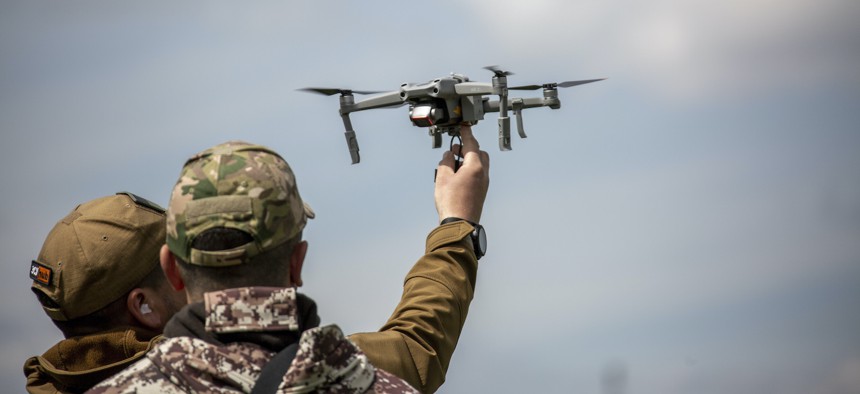
Ukrainian trainees learn to drop explosives devices from a drone in Ukraine, on May 12, 2023. Narciso Contreras / Anadolu Agency via Getty Images
Army Seeks Bomb-Carrying Drones Like Ukraine’s
Average U.S. soldiers could pilot lethal quadcopters—if they are ever fielded.
The U.S. Army wants to develop bomb-carrying drones similar to the jury-rigged commercial drones widely used in Ukraine, according to a service solicitation to industry.
The proposal-submission solicitation notes the drones’ utility to infantry, suggesting that lethal drones may one day be a common tool in the average infantry platoon’s kit.
U.S. Army Special Operations Command already operates a variety of smaller drones, most prominently the Switchblade suicide drone.
The wider Army, however, only operates the Skydio X2D unarmed reconnaissance drone at the small-unit level, according to the early-May posting by the Army Applications Laboratory. Skydio won a five-year fixed-price contract from the Army in early 2022, valued at $20 million per year.
Developing small, lethal drones is “vital for Army future combat operations,” the lab wrote in its call for submissions. Created in 2018 under Army Futures Command, the lab identifies commercial tools of potential use to soldiers.
The solicitation says drones must come from the Defense Department’s vetted list. Known as the Blue UAS list, it includes a mix of quad-copters—similar to the DJI Mavic 3 that is widely used in Ukraine—and winged drones. The proposal specifically disallows WingtraOne, a 4-foot winged drone, but does not say why.
The solicitation also says soldiers must be able to drop munitions using the drones’ controller—and that suppliers should eventually integrate this feature into “ATEK.”
The Army Applications Laboratory did not respond to questions about “ATEK” by publication time, but it may be a reference to ATAK, an Air Force-designed Android app used for live video feeds and geospatial mapping, among other things.
The solicitation says the drone’s munitions must also be more deadly than a M67 fragmentation grenade. The Army’s Combat Capabilities Development Command is already working on dropping M67 grenades from the Skydio X2D, according to the request, mimicking widely used tactics in Ukraine.
Such drones could be useful for harassing an adversary, with particularly deadly results if the enemy is caught unawares. “Whenever you can get a cheap kill, you should go for the cheap kill,” said Scott Boston, a senior defense analyst at the RAND Corporation.
The unmanned systems could also be armed with an anti-tank warhead, potentially replacing costlier systems like the Javelin missile, Boston added.
Fielding such cheap drones would also help Army units get in more hands-on training and mean that soldiers wouldn’t run out of them in a firefight, Boston said.
The solicitation follows a December request by the Army Application Laboratory that drone companies explain how their systems could be used as loitering munitions. That posting said the Army was researching the effort because of drones’ use in the war in Ukraine.
According to the new solicitation, the drones would be used by soldiers in mechanized units—from the squad to “potentially” the brigade level—and would need at least a 500-gram payload. The possible targets include enemy soldiers and vehicles.
Ukrainians and Russians have frequently used commercial drones to attack each other.
At one drone-training center Defense One toured in Ukraine, volunteers rigged a photography drone to drop bombs by using the drone’s camera flash to activate a light-sensitive switch.
Both sides also pack explosives onto first-person-view drones—originally designed for racing and designed to go very fast—turning them into suicide drones. K-2, commander of a battalion within Ukraine’s 54th brigade, told Defense One he has special units in charge of operating those drones.





